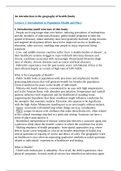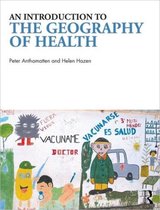An introduction to the geography of health (book)
Lecture 1: Introduction to Population Health and Place
1. Introduction (until structure of this book)
- People are living longer than ever before: reducing prevalence of malnutrition
and the incidence of infectious diseases; public health programs to limit the
spread of diseases; infant mortality rates have generally declined; rising incomes
and targeted development efforts have led to improved access to healthcare,
education, other services, enabling man people to enjoy improved living
standards.
- Low- and middle-income countries suffer from ‘a double burden of disease’, as
their healthcare systems struggle to cope with both infectious diseases and
chronic conditions associated with increasingly Westernized lifestyles (high
rates of obesity, chronic diseases such as cancer and heart disease).
- Fallen life expectancy over the past twenty years: sub-Saharan Africa is the
most affected largely as a result of high rates of HIV/AIDS.
What is the Geography of Health?
- Public health looks at population-wide processes and emphasizes health-
promoting behaviours that will generate benefit for broader the population.
Clinical medicine focusses on the health of individuals.
- Malaria risk South America: concentrated in an area with high temperatures,
and in the Amazon Basin with abundant precipitation. Temperature and rainfall
patterns influence both vegetation and the likelihood of standing water,
supporting the hypothesis that these conditions might influence conditions for
the mosquito that transmits malaria. Elevation also appears to be significant,
with the high Andes Mountains standing out as an area largely without malaria.
- Space: concerned with identifying where things are (e.g. coordinates).
- Place: unique locations with attributes that make them distinctive, often related
to the cultural meanings attached to a particular setting. Someone can have a
sense of place associated to it.
- Biomedical interpretation of disease: interaction between a causative agent and
a patient to think about the broader context in which the conditions has arisen.
- Shifting emphasis of health geography: from spatial approaches (e.g. where
best to locate a new hospital) to a focus on broader definitions of health (e.g.
critical questions of equality of access and ethics of care). The geographic work
on healthcare is now often incorporating qualitative methods to tackle questions
related to individuals’ experiences of healthcare and healing.
What is Health?
- Child with chicken-pox is unhealthy. First of all, the child experiences clear
physical symptoms. Second, medical science has identified an infectious agent
,that causes the disease: the chickenpox virus.
- Many mental illnesses are difficult to diagnose because symptoms may be
difficult to distinguish from a range of ‘normal’ behaviours. In many cases, a
specific agent such as a virus is not present.
- WHO: ‘’a state of complete physical, mental and social well-being and not
merely the absence of disease or infirmity’’. The definition is so utopian as to
preclude any individual from ever actually achieving ‘health’.
Evolving Approaches to Health Geography
- How we conceptualize disease and health has an influence on how we treat
disease and people who are considered to be ill.
- The Hippocratic Corpus discusses medical ethics, holistic medicine, and
environmental influences on health. Hippocrates is often described as an early
proponent of environmental determinism, which posits that health conditions,
body types, and personalities are directly attributed to environmental factors,
especially climate.
- The suggestion that human health and even behaviours can be explained
largely by environmental factors has a tarnished history as it was used to justify
racist policies, which claims that the environment limits the potential of some
populations.
- From the mid-twentieth century, much work in medical geography began to
focus on the theoretical framework that the environment offers opportunities and
imposes constraints, but that a human free-will and ability, or human agency,
allows people to make choices within this framework. So, considering how
humans interact with their physical and social environments as cultural beings.
- Disease ecology: humans are viewed as one part of an integrated disease cycle,
rejecting the idea that humans and the environment should be seen as separate
entities.
- Holistic medicine is premised on the idea that good health is based on more
than just physical soundness, but must also incorporate spiritual and emotional
wellness.
- Social and cultural theory are increasingly being used within health geography.
Concepts such as politics, economics, race, gender, and marginalized
populations have become increasingly important in these ‘post-medical’
approaches to health and healthcare. These approaches reject the positivist and
reductionist views that health and disease can be explained simply by the
presence or absence of a pathogen, and instead consider the role of a person’s
broader social and psychological life.
- The importance of place to health studies has changed over time:
• Early interest following the Hippocratic tradition: focused on the influence of
environment on health, with places viewed simply as containers for attributes
such as a particular climate and vegetation.
• Quantitative revolution of 1960s: emphasis on abstract space, considering how
,factors such as location, connections, and connectivity are significant to health.
• New approached to health geography: emphasise the spatial construction of
society and social processes. The notion of place has been reimagined to include
the significance of places to particular individuals, as well as the significance of
a persons’ place-in-the-world.
7. Power and Politics of Health (p. 125-132 until fertility policy)
‘’New’’ Geographies of Power
- Power differential characterize many other interactions related to health: A
power differential exists between doctors and patients in both legally mandated
and informal ways. Legally, doctors have the power to prescribe medications
and perform certain procedures, to which patients otherwise do not have access.
Formal form, professional medical knowledge is often valued by society over
lay or informal knowledge. Healthcare has, therefore been implicated with
disempowering individuals by subjecting them to governmental and professional
oversight and intervention.
- Empowerment by healthcare: through actively pursuing biomedical solutions
to their health problems in order to tap into the power that they perceive to be
associated with ‘modern’ or ‘technological’ therapies.
- The postmodern reading suggests that we must explore the role of the induvial
and the community in responding to these structures.
- Disability geography: people with disabilities are frequently discriminated
against in ways that lead to socio-spatial exclusions.
Segregation and Health
- Structures of power in society-at-large maintain spatial and social boundaries,
systematically marginalizing people identified by their difference. Not only
people in poor health are marginalized in this way. Other populations such as the
homeless, itinerant populations, and refugees experience similar socio-spatial
exclusions. These exclusions may themselves have health ramifications, leading
to a vicious cycle in which exclusion compromises health, and ill-health then
lead to further exclusion. Example: relationship between homelessness and
mental health problems. Mental health problems are often a risk factor for
homelessness, while homelessness forms a significant barrier to getting
psychiatric or psychological care.
- Quarantine is a clear spatial manifestation of the idea that ‘dangerous’ bodies
should be removed from public spaces in the name of health. Example: isolation
of lepers remained a common practice in many countries well into the twentieth
century. Build them in in remote areas, often island, reinforcing the notion of
isolation as a means of removing contagion from society. To avoid negative
connotations, the name “Hansen’s Disease’ is now often used instead of
‘leprosy’.
, Power and the ‘’Body’’
- When bodies are socially constructed, they are not born but made.
- A key focus of disability geographers has been how society constructs
understandings of disabled bodies and the implications of these understandings
in terms of how we expect disabled people look and act.
- The writings of Michel Foucault have been especially relevant to the study of
the body and power. Foucault argued that the body is the ultimate point at which
political states exercise ideological control, and that the body is therefore a focal
point of state-mandated discipline. State systems, such as education, law and
medicine, ultimately operate at the scale of the body, disciplining bodies that
violate established boundaries and keeping bodies economically and politically
productive. Medicine then serves to label these bodies as ‘deviant’ or ‘normal’,
‘unhygienic’ or ‘hygienic’, or in need of the discipline, influencing how we
believe people should look and act.
- Bodies, and spaces they occupy, have thus been framed as sites of both
oppression and resistance. As geographers, we can consider the ways in which
these expectations can be place-based, influencing what we expect particular
bodies to do in particular places. Example: why are some women in the US and
UK not breastfeeding in spite of publicly available information about the
medical benefits of the practice. Many women continue to be embarrassed by
the act of breastfeeding and so women seek ‘liminal spaces’, places used as
‘transitional zones, which women move in to breastfeed and out of to reintegrate
with society and ‘normal’ daily activities’. Women’s perception that they must
conform to social norms when breastfeeding is situated in a social context in
which breasts are constructed as sexualized parts of the body, requiring women
to carefully regulate where and when they feed their babies.
Surveillance and Public Health
- Surveillance medicine: trend towards increasing societal oversight of
individual health. This surveillance medicine targets not only the sick, but also
the healthy, with the idea that individuals and populations ‘(hang) precariously
between health and illness’. Examples: monitor the development of children via
well-baby clinics and mother-and-child health programs have interpreted as a
way for society to keep an eye on the bodies of children. Skin cancer,
symptomatic individuals are treated within the medical system, but the
behaviour of asymptomatic individuals has also become a target via public
health campaigns. In such cases, power relations are often made invisible as
these practices are voluntarily imposed, with individuals, self-regulation their
behaviour to conform to societal expectations of what it is to be ‘healthy’.
- The surveillance medicine changed the social landscape, but has also spatial
implications. It has brought healthcare out of the hospitals into the community,
as disease has become not an event in an individual body, but has been
reinterpreted in terms of the ‘risk’ posed by everyday activities in everyday





